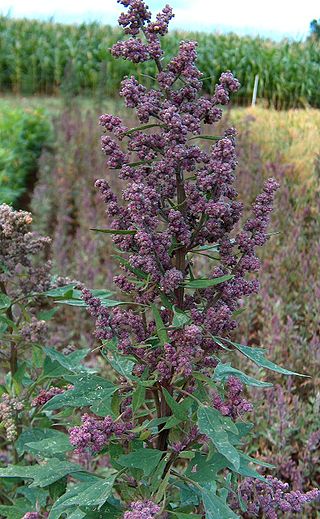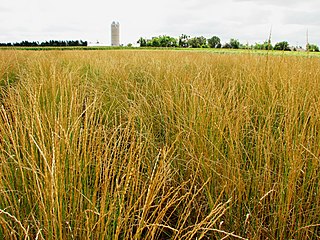
Quinoa is a flowering plant in the amaranth family. It is a herbaceous annual plant grown as a crop primarily for its edible seeds; the seeds are rich in protein, dietary fiber, B vitamins and dietary minerals in amounts greater than in many grains. Quinoa is not a grass but rather a pseudocereal botanically related to spinach and amaranth, and originated in the Andean region of northwestern South America. It was first used to feed livestock 5,200–7,000 years ago, and for human consumption 3,000–4,000 years ago in the Lake Titicaca basin of Peru and Bolivia.

Sorghum or broomcorn is a genus of about 25 species of flowering plants in the grass family (Poaceae). Some of these species are grown as cereals for human consumption, in pastures for animals as fodder, and as bristles for brooms. Sorghum grain is a nutritious food rich in protein, dietary fiber, B vitamins, and minerals.

Einkorn wheat can refer either to a wild species of wheat (Triticum) or to its domesticated form. The wild form is T. boeoticum, and the domesticated form is T. monococcum. Einkorn is a diploid species of hulled wheat, with tough glumes ('husks') that tightly enclose the grains. The cultivated form is similar to the wild, except that the ear stays intact when ripe and the seeds are larger. The domestic form is known as "petit épeautre" in French, "Einkorn" in German, "einkorn" or "littlespelt" in English, "piccolo farro" in Italian and "escanda menor" in Spanish. The name refers to the fact that each spikelet contains only one grain.

Emmer wheat or hulled wheat is a type of awned wheat. Emmer is a tetraploid. The domesticated types are Triticum turgidum subsp. dicoccum and T. t. conv. durum. The wild plant is called T. t. subsp. dicoccoides. The principal difference between the wild and the domestic forms is that the ripened seed head of the wild plant shatters and scatters the seed onto the ground, while in the domesticated emmer, the seed head remains intact, thus making it easier for humans to harvest the grain.

Domestication is a multi-generational mutualistic relationship between humans and other organisms, in which humans took over control and care to obtain a steady supply of resources including food. The process was gradual and geographically diffuse, based on trial and error.

Cicer is a genus of the legume family, Fabaceae, and the only genus found in tribe Cicereae. It is included within the IRLC, and its native distribution is across the Middle East and Asia. Its best-known and only domesticated member is Cicer arietinum, the chickpea.

The cowpea is an annual herbaceous legume from the genus Vigna. Its tolerance for sandy soil and low rainfall have made it an important crop in the semiarid regions across Africa and Asia. It requires very few inputs, as the plant's root nodules are able to fix atmospheric nitrogen, making it a valuable crop for resource-poor farmers and well-suited to intercropping with other crops. The whole plant is used as forage for animals, with its use as cattle feed likely responsible for its name.

Pearl millet is the most widely grown type of millet. It has been grown in Africa and the Indian subcontinent since prehistoric times. The center of diversity, and suggested area of domestication, for the crop is in the Sahel zone of West Africa. Recent archaeobotanical research has confirmed the presence of domesticated pearl millet on the Sahel zone of northern Mali between 2500 and 2000 BC. 2023 was the International Year of Millets, declared by the United Nations General Assembly in 2021.

The founder crops or primary domesticates are a group of flowering plants that were domesticated by early farming communities in Southwest Asia and went on to form the basis of agricultural economies across Eurasia. As originally defined by Daniel Zohary and Maria Hopf, they consisted of three cereals, four pulses, and flax. Subsequent research has indicated that many other species could be considered founder crops. These species were amongst the first domesticated plants in the world.
Fungiculture is the cultivation of fungi such as mushrooms. Cultivating fungi can yield foods, medicine, construction materials and other products. A mushroom farm is involved in the business of growing fungi.

Agriculture began independently in different parts of the globe, and included a diverse range of taxa. At least eleven separate regions of the Old and New World were involved as independent centers of origin. The development of agriculture about 12,000 years ago changed the way humans lived. They switched from nomadic hunter-gatherer lifestyles to permanent settlements and farming.

During 10,000 years of cultivation, numerous forms of wheat, many of them hybrids, have developed under a combination of artificial and natural selection. This diversity has led to much confusion in the naming of wheats. Genetic and morphological characteristics of wheat influence its classification; many common and botanical names of wheat are in current use.

Sorghum bicolor, commonly called sorghum and also known as great millet, broomcorn, guinea corn, durra, imphee, jowar, or milo, is a grass species cultivated for its grain, which is used for food for humans, animal feed, and ethanol production. Sorghum originated in Africa, and is now cultivated widely in tropical and subtropical regions. Sorghum is the world's fifth-most important cereal crop after rice, wheat, maize, and barley, with 61,000,000 metric tons of annual global production in 2021. S. bicolor is typically an annual, but some cultivars are perennial. It grows in clumps that may reach over 4 metres (13 ft) high. The grain is small, ranging from 2 to 4 millimetres in diameter. Sweet sorghums are sorghum cultivars that are primarily grown for forage, syrup production, and ethanol; they are taller than those grown for grain.

Triticeae is a botanical tribe within the subfamily Pooideae of grasses that includes genera with many domesticated species. Major crop genera found in this tribe include wheat, barley, and rye; crops in other genera include some for human consumption, and others used for animal feed or rangeland protection. Among the world's cultivated species, this tribe has some of the most complex genetic histories. An example is bread wheat, which contains the genomes of three species with only one being a wheat Triticum species. Seed storage proteins in the Triticeae are implicated in various food allergies and intolerances.

Chenopodium berlandieri, also known by the common names pitseed goosefoot, lamb's quarters, and huauzontle (Nahuatl) is an annual herbaceous plant in the family Amaranthaceae.

Genetic pollution is a term for uncontrolled gene flow into wild populations. It is defined as "the dispersal of contaminated altered genes from genetically engineered organisms to natural organisms, esp. by cross-pollination", but has come to be used in some broader ways. It is related to the population genetics concept of gene flow, and genetic rescue, which is genetic material intentionally introduced to increase the fitness of a population. It is called genetic pollution when it negatively impacts the fitness of a population, such as through outbreeding depression and the introduction of unwanted phenotypes which can lead to extinction.

Thinopyrum intermedium, known commonly as intermediate wheatgrass, is a sod-forming perennial grass in the Triticeae tribe of Pooideae native to Europe and Western Asia. It is part of a group of plants commonly called wheatgrasses because of the similarity of their seed heads or ears to common wheat. However, wheatgrasses generally are perennial, while wheat is an annual. It has gained the Royal Horticultural Society's Award of Garden Merit as an ornamental.

Perennial rice are varieties of long-lived rice that are capable of regrowing season after season without reseeding; they are being developed by plant geneticists at several institutions. Although these varieties are genetically distinct and will be adapted for different climates and cropping systems, their lifespan is so different from other kinds of rice that they are collectively called perennial rice. Perennial rice—like many other perennial plants—can spread by horizontal stems below or just above the surface of the soil but they also reproduce sexually by producing flowers, pollen and seeds. As with any other grain crop, it is the seeds that are harvested and eaten by humans.

A perennial grain is a grain crop that lives and remains productive for two or more years, rather than growing for only one season before harvest, like most grains and annual crops. While many fruit, nut and forage crops are long-lived perennial plants, all major grain crops presently used in large-scale agriculture are annuals or short-lived perennials grown as annuals. Scientists from several nations have argued that perennial versions of today's grain crops could be developed and that these perennial grains could make grain agriculture more sustainable.
Perennial crops are a perennial plant species that are cultivated and live longer than two years without the need of being replanted each year. Naturally perennial crops include many fruit and nut crops; some herbs and vegetables also qualify as perennial. Perennial crops have been cultivated for thousands of years; their cultivation differs from the mainstream annual agriculture because regular tilling is not required and this results in decreased soil erosion and increased soil health. Some perennial plants that are not cultivated as perennial crops are tomatoes, whose vines can live for several years but often freeze and die in winters outside of temperate climates, and potatoes which can live for more than two years but are usually harvested yearly. Despite making up 94% of plants on earth, perennials take up only 13% of global cropland. In contrast, grain crops take up about 70% of global cropland and global caloric consumption and are largely annual plants.



















